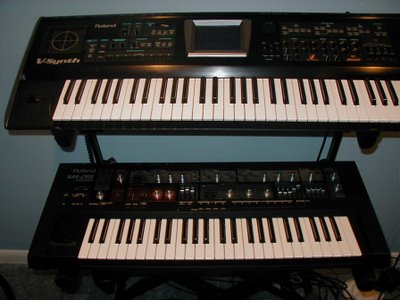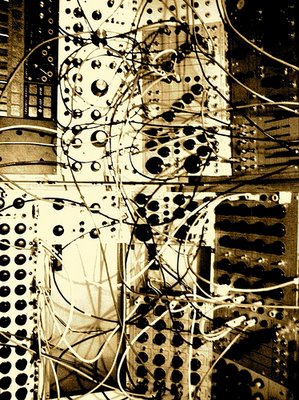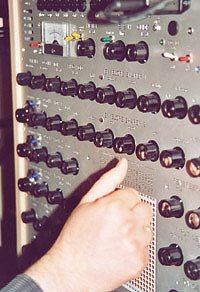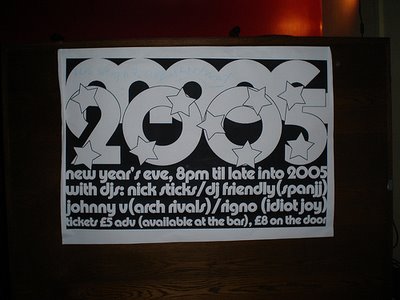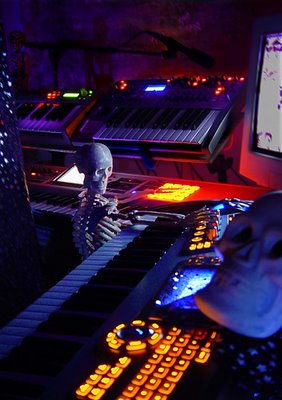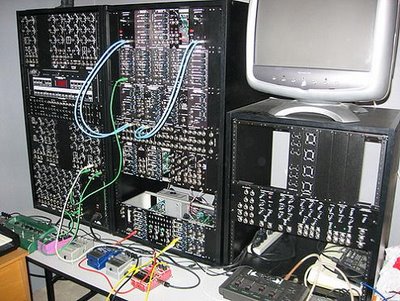 flickr by devowski. I keep telling myself I'm going to skip the next shot by devowski and then he comes up with stuff like this. A Casio Rock. This brings a new meaning to the saying, dead weight.
flickr by devowski. I keep telling myself I'm going to skip the next shot by devowski and then he comes up with stuff like this. A Casio Rock. This brings a new meaning to the saying, dead weight.
Thursday, July 20, 2006
Casio Rock - New Flickr Shot
 flickr by devowski. I keep telling myself I'm going to skip the next shot by devowski and then he comes up with stuff like this. A Casio Rock. This brings a new meaning to the saying, dead weight.
flickr by devowski. I keep telling myself I'm going to skip the next shot by devowski and then he comes up with stuff like this. A Casio Rock. This brings a new meaning to the saying, dead weight.
Thomas Organ with Moog Synth

via Craigslist
"Thomas Celebrity Royale 571 with MOOG Synthesizer Leslie Rotating speaker for Chorus or Tremelo A Fancy Foot Drum Machine all kinds of cool organ sounds, bass pedals, original seat and many piano and pedal books."
Deepsonic Videocollection
Click here for a 10.2M WMV. Check out Deepsonic for more on what the site has to offer.
via brian comnes in the comments of this post.
10 step sequencer on YouTube
Update via the comments:
"this is synthmonger's stuff. he's building what look like fairly nice little noiseboxes, sequencers, and so on and selling them fairly cheap direct and on ebay. i've got one of his CMOS VCO boxes on order and, if it's as good as it looks, i'll probably be picking up one of these sequencers as well -- where else can you get a standalone 10-step analog sequencer for under $200?"
Roland Info Cards
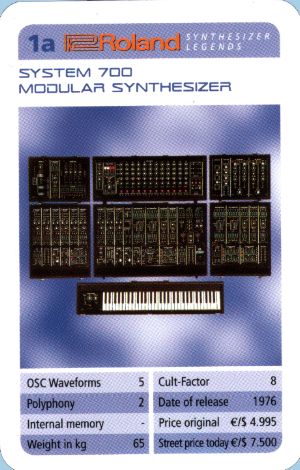 Title link takes you there. via sequencer.de.
Title link takes you there. via sequencer.de. This reminds me. I still need to get my GMedia Trump Cards.
Acidlab Bassline / Roland TR-606 - New Flickr Shot
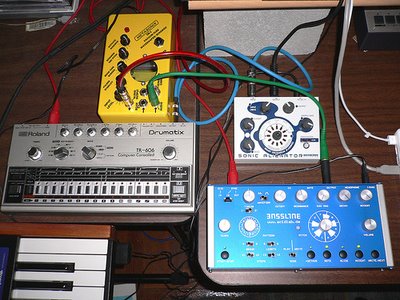 flickr by JSRockit.
flickr by JSRockit."Acidlab Bassline through a Metasonix TM-1 Wave Shaper synced to a Roland TR-606 Drum Machine through a Frostwave Sonic Alienator. DIRTY!"
Cat - Up and Running
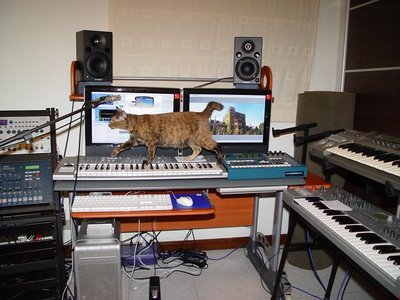 Yep... Let's all be glad it's just a midi controller and not a synth, althought that MS2000 is about to get nicked. : ) Via Another Day in Paradise.
Yep... Let's all be glad it's just a midi controller and not a synth, althought that MS2000 is about to get nicked. : ) Via Another Day in Paradise.
Wednesday, July 19, 2006
Waldorf Wave Still For Sale
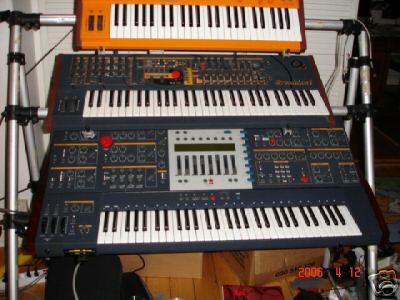 This is probably only interesting to me, but that Waldorf Wave that was up for sale in Sweden back in April is up for sale again. It didn't sell the first time. Asking price is $6000. What's also interesting is the asking price was $7000 when I put up the previous post but the link to that auction shows it ended with 0 bids at $6000. It's all supply and demand and the demand doesn't appear to be there at that price.
This is probably only interesting to me, but that Waldorf Wave that was up for sale in Sweden back in April is up for sale again. It didn't sell the first time. Asking price is $6000. What's also interesting is the asking price was $7000 when I put up the previous post but the link to that auction shows it ended with 0 bids at $6000. It's all supply and demand and the demand doesn't appear to be there at that price.
CP Music
 Title link takes you to Pete's CP Music website, home to a few DIY projects, synth shots, samples, and more. One of Pete's projects is a Phase Shifter based on the CEM3320. There are images and a sample of his Prophet 600 going through the phaser on site. Also, make sure to check out the gallery when you get there. There are some nice shots including the DK Synergy a rare digital synth from the early 80s. You can find more on the Syndergy here. And of course some lovely waveshape shots.
Title link takes you to Pete's CP Music website, home to a few DIY projects, synth shots, samples, and more. One of Pete's projects is a Phase Shifter based on the CEM3320. There are images and a sample of his Prophet 600 going through the phaser on site. Also, make sure to check out the gallery when you get there. There are some nice shots including the DK Synergy a rare digital synth from the early 80s. You can find more on the Syndergy here. And of course some lovely waveshape shots.
Spaceware on the PDP-1
 flickr by the earthling. The caption reads, "Spacewar was the first video game... ever. Yes, I played it on this restored PDP-1." I wonder if it produced sound and if so, how. If you have any idea if the PDP-1 could produce sound, please comment.
flickr by the earthling. The caption reads, "Spacewar was the first video game... ever. Yes, I played it on this restored PDP-1." I wonder if it produced sound and if so, how. If you have any idea if the PDP-1 could produce sound, please comment.via unrest.
Update via solipsisnation in the comments:
"Well, PDP systems were digital, and their CPUs were waaaay too slow for anything resembling real-time sound.
That said, the PDP series was used for electronic music composition, and while I was going to mention Paul Lansky's "Mild und Leise" (AKA "the neat FM-y noises from Radiohead's 'Idiotique'"), that appears to have been made on an IBM: link
Here's a timeline that mentions PDP-series computers, though: link
Of interest are these paragraphs:
"In 1968, Barry Vercoe working at Princeton developed a very fast version of MUSIC IV B, entitled MUSIC 360 [9] [12] for the new generation IBM 360 mainframes. In 1973 at MIT, Vercoe developed a compact version of MUSIC called MUSIC 11 [3]. It was written in PDP-11 assembler code for the PDP-11 computer. This was the first digital music synthesis program for mini-computers with a keyboard and teletypewriter VDU (Visual Display Unit).
John Chowning and James Moorer at the University of Stanford, California wrote another version of MUSIC called MUSIC 10 [13] for the PDP-10 in 1975. Further improvements to MUSIC 10 were implemented both at Stanford and IRCAM (Institut de Recherche et Coordination Acoustique/Musique) in Paris. The IRCAM implementation allowed input of short external samples through the use of Analog-to-Digital (A/D) converters. The input could be analyzed digitally providing data for modifications and re-synthesis, in combination with internally generated sounds."
So, the PDP-1 was probably too primitive, but systems with a similar architecture could be used to synthesize audio in a very slow and painstaking way-- no realtime sound, for sure. These were the days before microprocessors, and even KHz CPUs were still in the future. "
Acid ohne Roland's TB303
 Title link takes you to a list of TB acid tracks featuring various synths inlcuing:
Title link takes you to a list of TB acid tracks featuring various synths inlcuing: Propellerheads Rebirth
Yamaha AN1X
Kawai K5000S
Waldorf Microwave XT
Korg Z1
Korg Poly 61
Yamaha FX900
Hohner HS-1
Access Virus C
3x Creakbox Beta
MAM Freebass FB383
Audiorealism Bassline V1.5
Roland JD800
Each track lists what synths were used. These are really good demos.
EMS Clones on Sequencer.de
Ken Elhardt's Studio
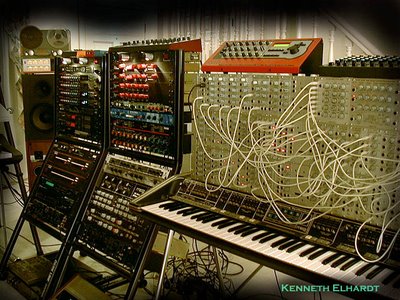
With all this talk about Elhardt possibly behing behind the SMS 2000, I thought I'd put up a post on his studio.
Tuesday, July 18, 2006
Seekers SMS 2000 Resurfaces
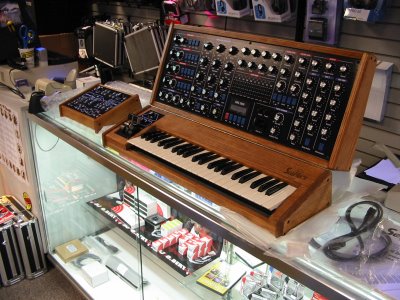
Update: Pevious posts in case you missed them:
1 (original post with convention shots)
2 (the SMS2000 in plastic)
3 (the first prototype) : )
Click here for a post on the SOS forum by SteveCooperman who claims he has played with one - shots saved below for posterity.
Thanks goes to Dennis Verschoor for sending this one in.
The following is the full post:
"About a week ago I received a call from a friend who likes to hop from shop to shop looking for vintage gear or interesting new items. He was standing infront of a synthesiser and describing it to me on his mobile. His description intrigued me to such an extent, I decided to take the hour plus drive to see it for myself. It happened that the synthesiser just arrived that morning and wasn't there more than three hours. After playing around with it a tad, I knew I had to have it. The synthesiser is a programmable monophonic analogue by Seekers called the SMS2000. I had never heard of the manufacturer but the bloke at the shop told me they made an analogue vocoder too.
What is it? The SMS2000 reminds me quite a bit of the Minimoog Voyager. It has an adjustable knob interface like the Minimoog, a 3 1/2 octave keyboard, a crazy set of performance levers, and even a joystick. See pictures at the URLs provided below. But it seems as if Seekers wanted to one-up the Moog Voyager in almost every respect. One more oscillator, one more LFO, one more ADSR, ring modulator, fixed filter bank - like a Moog MuRF right in there but with frequencies set to those of a typical equaliser, full dual filters, and something called an XCU is also included. That's an expansion control unit which is a breakout box similar to the Moog VX-351. I don't own a modular, but it will come in handy patching into my MS-20.
I had been on the fence for some time as to whether I wanted to put out the money for a Voyager. But there always seemed to be too many little niggles and limitations with it. The Seekers seems to have overcome many of those. For example the Voyager can't invert control voltages, the Seekers can. The Voyager forces you into using the display for programming, the Seekers puts every function out there with its own knob or button. The display is only used for patch storage and retrieval, and MIDI related functions. The Seekers has a joystick on the knob interface where vertical controls one filter and the horizontal the other filter. At first I thought it a bit daft that it couldn't be patched to control all kinds of other things too, but when I considered that it seemed like an extra bonus thrown in there, and most synthesisers don't have one at all, then it seemed pretty cool.
The manual is adequate but full of typos and poor translations. Seekers is a Japanese company. There is no mention as to whether the filters are imitations of well known filters or not. Only that the 24dB/octave is a ladder filter and the 12dB/octave is a state variable. But both filters contain lowpass and highpass which can also be combined for bandpass. Both can self resonate.
I've only had the SMS for a week, and with a busy work schedule I haven't had much time to delve deeply into it yet. I'll write a more extensive review after I spend more time with it. The owner of the shop seemed to indicate these are trickling off the assembly line and it could be a couple of months before another shows up. I would expect major players like Turnkey to carry them when they begin to proliferate.
Here are some photos of the SMS. My flat is getting a bit too crowded with audio gear, so it's only a temporary setup. The MS-20 went to the floor to make room for my SMS. My Micromoog will probably be up for sale soon. I can't keep it all."
Aussie Babies Love the Jupiter 8
 This one including title in via Ross. The title, of course, is in reference to this post. I thought the following blurb from Ross was pretty funny. Makes me wonder if I should have named my daughter Cynthia. : )
This one including title in via Ross. The title, of course, is in reference to this post. I thought the following blurb from Ross was pretty funny. Makes me wonder if I should have named my daughter Cynthia. : )"It must be an Australian thing with babies and Jupiter 8s
My son OSCar( yes named after the synth, it was that or Roland
Oberheim), loves playing the Jupiter so much so he calls it Daddy, and
he doesnt call me daddy???:-)"
Thanks Ross. BTW, I thought of Roland Oberheim as well, but my wife killed that one pretty quickly, and we had a daughter, so...
Noise FX
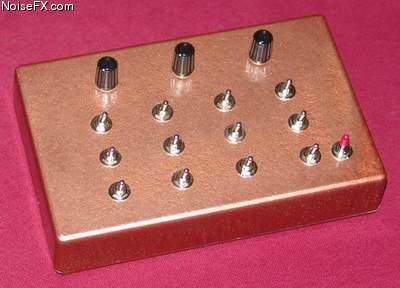 Love the copper case on this.
Love the copper case on this. via sequencer.de. BTW, looks like sequencer.de has had a facelift. Looks nice!
Title link takes you to Noise FX.
Details:
It's a synth; a power electronics artist's wet dream. It's a noise box; a noisician's nirvana. It's a lot of things, but one thing it isn't is a full fledged keyboard. It's basically an oscillator on steroids with many filtering effects. Each switch yields new sounds ranging from squeels, to bleeps, to pulsating power electronics doom. No need for an amp, this sucker is loud. It has a slight learning curve as it is an unorthodox sort of oscillator but rest assured, when you get one of these in your hands, you can definately start making sounds right away. You can tweak it live to add changes to a song, or if you are a techno fanatic, you can use it to sample some strange sounds, do whatever.
* 3 knobs to changes the frequency, modulations, etc.
* 11 switches to change filtering effects, pitches, throbs, etc.
* On/Off switch
* Audition Push Button
* Runs off 9v power adapter (Boss style, we recommend Godlyke)
* It's LOUD!
Moog Sonic Six
 Title link takes you to more shots sent my way via Lee including shots of the inside. Lee asks, "Anyone know what the 8 pin "accessory" jack is for?" If you know please post in the comments.
Title link takes you to more shots sent my way via Lee including shots of the inside. Lee asks, "Anyone know what the 8 pin "accessory" jack is for?" If you know please post in the comments.Update via the comments:
Loscha said...
The 6 pins are labelled on the service manual as:
Ground
+15
-15
N/C
Pitch
Trigger
20SYL - Beat Making Video
"The producer's name is 20syl. He is from France. He is also a member of Hocus Pocus and C2C. This is an in depth video on how to make hip-hop beats. I have made some hot joints with him. Check them out here."
Crap 2600
 Title link takes you to a predominantly Atari 2600 track. Via elmosexwhistle on this VSE post:
Title link takes you to a predominantly Atari 2600 track. Via elmosexwhistle on this VSE post:"Here's my track with a lot of atari 2600 sounds on, and a few parts from the unknown64 vst plugin to beef it up and fill it out...it's called "crap 2600". I love the atari's snare drums, theyre so chunky and gratifying!"
Monday, July 17, 2006
Ode To Synthesizers
By Joshua Langberg via AH:
"Hello,
I had to write some poems for my poetry class. One had to be an ode, what do I owe more to than my synthesizers?! I hope some of you enjoy it:
Oscillators that stay in tune.
Filter sweeps will make girls swoon.
Black ebony, white ivory,
49, 61 and 88 key.
All made up of circuit boards,
if polyphonic you can play chords.
Special chips make you temperature stable,
unless of course, you have a wave-table.
Multiple envelopes contour the sound,
while distortion effects bring forth the hellhound.
Frequency modulation is the control,
that combines oscillator sounds, it can shake the soul.
With a keyboard or rack-mountable,
using a TRS or XLR cable.
Voltage controlled amplifier,
How you titillate my desire.
One can never have too many LFO’s,
they’ll sound like the engine of a UFO.
Blipps and bleeps, multimode filters squelching,
most are made in Tokyo, not Beijing.
Sample and hold, you turn my world to chaos,
random voltages you are the embodiment of Eros.
Waldorf, Quasimidi, Ensoniq, and Polyfusion,
you bring me out of dissolution.
Oberheim, Arp, E-MU, and Access,
give me the need to continually practice.
Moog, Roland, Korg, and Sequential,
you make the most of my potential."
"Hello,
I had to write some poems for my poetry class. One had to be an ode, what do I owe more to than my synthesizers?! I hope some of you enjoy it:
Oscillators that stay in tune.
Filter sweeps will make girls swoon.
Black ebony, white ivory,
49, 61 and 88 key.
All made up of circuit boards,
if polyphonic you can play chords.
Special chips make you temperature stable,
unless of course, you have a wave-table.
Multiple envelopes contour the sound,
while distortion effects bring forth the hellhound.
Frequency modulation is the control,
that combines oscillator sounds, it can shake the soul.
With a keyboard or rack-mountable,
using a TRS or XLR cable.
Voltage controlled amplifier,
How you titillate my desire.
One can never have too many LFO’s,
they’ll sound like the engine of a UFO.
Blipps and bleeps, multimode filters squelching,
most are made in Tokyo, not Beijing.
Sample and hold, you turn my world to chaos,
random voltages you are the embodiment of Eros.
Waldorf, Quasimidi, Ensoniq, and Polyfusion,
you bring me out of dissolution.
Oberheim, Arp, E-MU, and Access,
give me the need to continually practice.
Moog, Roland, Korg, and Sequential,
you make the most of my potential."
MiniKorg 700 in Custom Case
 Two shots of a Korg MiniKorg 700 in a custom case. Click here for shots on what they normally look like.
Two shots of a Korg MiniKorg 700 in a custom case. Click here for shots on what they normally look like.Title link takes you to the listing on Craigslist where I pulled these from - while it's up.
"guts of a Korg mini....in a custom case!"
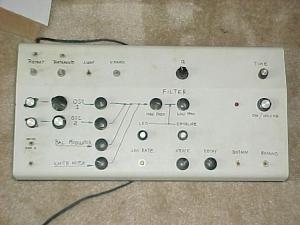
Hawkind EMS Putney
 If you have $6250 to spare, this one can be yours. : ) Title link takes you there. Shots saved here for posterity.
If you have $6250 to spare, this one can be yours. : ) Title link takes you there. Shots saved here for posterity."This is a pre- Prestopatch unit. It is an earlier model that has had the power supply upgraded. It is autographed by Dave Brock of Hawkwind. VCO3 works,veneer, needs adjusting (if you want, I like this flaw). This is one of the most musical sounding VCS3 I have ever seen. Many sound like lab gear. The same is true with Minimoogs. That's why Alien Planetscapes and Hawkwind used this synth and kept it in the family."
Eric Frampton Studio Shots

Click here for more. This one's for the dogs. ; )
Dogs: 3, Cats: I'm not even going to try and count.
That's a MOTM BTW.
ARP 2600 Modules
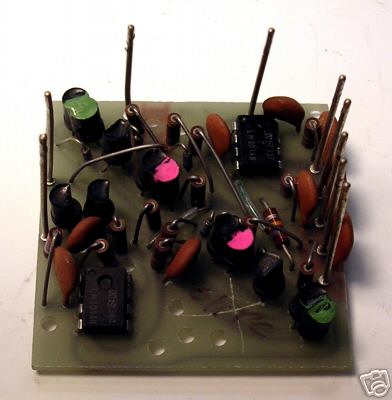
ARP 2600 Balanced Modulator Module 4014

ARP 2600 Soloist Moog Filter 4012
both via this set of auctions.
Sunday, July 16, 2006
PREVIOUS PAGE
NEXT PAGE
HOME













© Matrixsynth - All posts are presented here for informative, historical and educative purposes as applicable within fair use.
MATRIXSYNTH is supported by affiliate links that use cookies to track clickthroughs and sales. See the privacy policy for details.
MATRIXSYNTH - EVERYTHING SYNTH













© Matrixsynth - All posts are presented here for informative, historical and educative purposes as applicable within fair use.
MATRIXSYNTH is supported by affiliate links that use cookies to track clickthroughs and sales. See the privacy policy for details.
MATRIXSYNTH - EVERYTHING SYNTH

